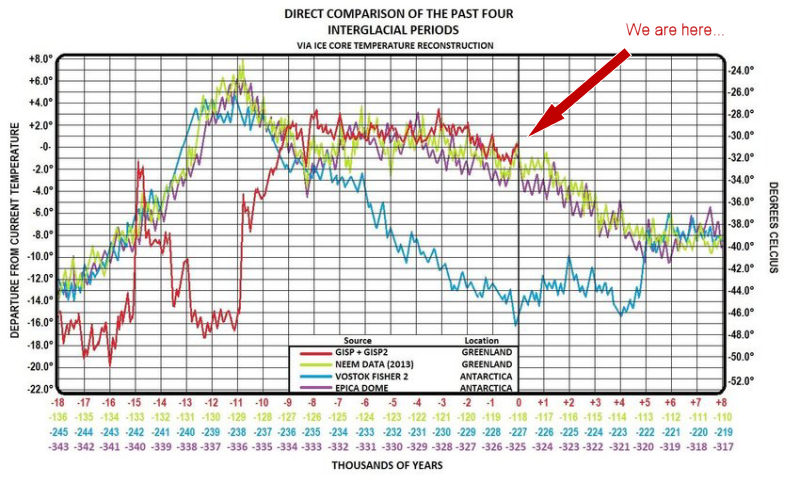Four Interglacials

10/11/2019 12:05 - Posted by Tom van Leeuwen
This picture is part of a very interesting
paper by independent researcher
Brian Catt about the effects of magma and volcanism on the
ocean heating through glaciation cycles.
The graph of 4 Interglacial Data Sets was created by James Covington.
It shows the temperature for the last four interglacial periods. Each interglacial has it's own color:
- Red - The Holocene, from 18,000 years ago until today ("We are here...")
- Green - The Eemian , from 136,000 years ago until 110,000 years ago
- Blue - Interglacial "MIS 7", from 245,000 years ago until 219,000 years ago
- Purple - Interglacial "MIS 9", from 343,000 years ago until 317,000 years ago
The depicted periods are long enough to show not only the interglacials themselves but also their onset and decay into the following glacial periods.
The horizontal axis shows the time range for each interglacial in the corresponding color. The vertical axis shows the absolute temperature at the right-hand side and the difference from the current temperature on the left.
The data is obtained from ice cores from Greenland and Antarctica. The names for each source dataset are mentioned in the graph. These are
commonly accepted datasets, used by climate scientists as a proxy for average global temperatures.
Observing this graph, the first thing that catches the eye is the large difference, 28 °C, between the coldest episodes of the glacial periods and the warmest peaks of the interglacials.
During these fluctuations, life on Earth adapted to the ever-changing climate, improving after every throwback and finally producing our modern society.
Taking this into account, it's clear that
the forecasts made by some scientists, bureaucrats, politicians, the mainstream mass media,
16-year olds, your government and the global government about an apocalyptic warming of 2 °C, tipping points, and a runaway -irreversible- warming into Venus-like conditions
are a huge exaggeration.
Our current "Global Warming" is the small uptick marked with the "We are here..." arrow. The
natural transition from the Little Ice Age into the Current Warm Period is clearly visible. When you take a closer look, all four graphs sport this ongoing zig-zag movement, with three or four peaks every thousand years.
The current peak is no different than the rest of the all-natural, zig-zag peaks over the past 300 thousand years. There are lots of sudden, all-natural, warming and cooling periods much more extreme than the current one.
There is nothing "strange" with the current warming; nothing abnormal. The same pattern has been repeating itself over and over again, for natural causes, every 200 to 250 years.
One last observation. The interglacials
Eemian and
MIS 9 show almost the same temperature progression. The
Holocene had a strange start, the so-called
Younger Dryas, but started to follow the other two after that period.
MIS 7 starts with exactly the same progression as Eemian and MIS 9, but shows a strange cooling period, possibly due to four violent volcanic eruptions 233,000 to 230,000 years ago: first the Emmons Lake Caldera in today's Alaska, followed by the Reporoa Caldera, Maroa Caldera and
Rotorua Caldera on what's now called New-Zealands Northern Island. After that, it's temperature progression catches up with Eemian and MIS 9.
If the Holocene follows the progression of the previous three interglacials,
the Earth is due for a gradual cooling of 7 to 9 °C over the next 5 thousand years. The CO
2 emitted by human activity might keep the CO
2 greenhouse effect saturated for some time, mitigating the process and prolonging the benevolent climate of the Holocene that played a fundamental role in human development.
Tom van Leeuwen, October 11th, 2019.
